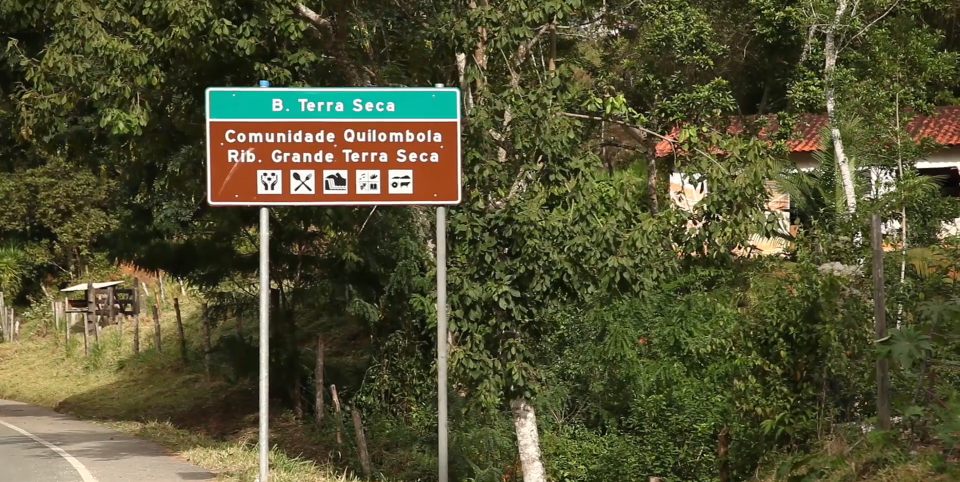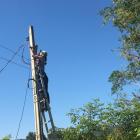
An organization of women farmers setup a community network in quilombo Ribeirão Grande/Terra Seca to support the commercialization of their agroecological products. Photo is a screengrab from a video by SOF Sempreviva Organização Feminista.
Today, Brazil has more than 15,000 quilombola communities, emerged as refuge for Black people who escaped repression during the period of slavery in Brazil between the 16th and 19th centuries. This includes quilombo Ribeirão Grande/Terra Seca, one of the seven quilombos present in the city of Barra do Turvo, Ribeira's Valley region. The valley is the largest remaining area of the Atlantic Forest in the country and in this region are 24 Guarani communities, 66 quilombola communities and around 7,000 family farming establishments that involve traditional peasants (the caipiras), traditional fisherpeople (caiçaras) and Indigenous and quilombola returnees from metropolises, who are the ones responsible for environmental preservation. RAMA, the organisation we have partnered with for the research, comprises different groups of women from the seven quilombos. These groups are quilombola ecological farmers who organise the women of the neighbourhood in associations and get together to strengthen resistance relations, improve their ecological agriculture practices, and market their products to consumers in the cities of Registro and São Paulo.
As a result of the partnerships with RAMA, the feminist organisations SOF (Sempreviva Organização Feminista – Always Alive Feminist Organisation) and MariaLab feminist hacker space, we have co-created the community network of quilombo Ribeirão Grande/Terra Seca. The proposal of the community network in this territory therefore began with the wish from RAMA and SOF of adding to and potentiating the sale of organic products through the women farmers of the Vale do Ribeira’s solidarity economy and agroecology networks, and preserve their ways of life and the youth in the territory.
After just over 3 years since we started the community network project in the quilombo Ribeirão Grande/Terra Seca, a global pandemic, and trying to make a single home internet connectivity useful for 20 families, some reflections arise. The whole process was really fullfilling and the proposal to have a feminist community network using popular education methodologies really proved to be the best approach in terms of community engagement and project sustainability. Sharing space, time and affections with quilombola women in feminist environment raised some questions, which have been analysed in the research where we address matters related to project development from an interseccional lenses. Some examples we brought up in the report lead us to raise some other questions, such as: Does the way we obtain or create connectivity shape the way we connect to it? We enquire whether the way connectivity reaches a given community shapes the uses they make of it.
Sharing space, time and affections with quilombola women in feminist environment raised some questions, which have been analysed in the research where we address matters related to project development from an interseccional lenses.
Connectivity means the state or extent of being connected or interconnected, while the verb connection has as synonyms unite, join, put together. With that in mind we want to explore all the connectivity that a community network does, in addition to the strict techniques of joining cables and signals.
Although the internet could be thought to be something that would strengthen connectivity, it has become a tool for the exact opposite of that, generating the waste of people's attention while hooked up for long periods with banalities and promises of easy money, malware and phishing attacks and propagating misinformation, just to name a few. The latter is proved to have caused the strengthening of far-right radicalism and fascism and even interfering in elections, such as the controversies involving Brazil's last election through Whatsapp and the scandal of the abuse of data by Cambridge Analytica via Facebook in the US elections in 2016. And with the pandemic, this scenario got even worse, whereas misinformation has done a great disservice in the fight against the pandemic as well, including misleading the population regarding vaccination, which has cost plenty of lives and wasted resources of public hospitals.
Now, when we think about processes of building community networks, how does community protagonism reverberate in the uses made of the network? Or rather, what types of connection are built from this community engagement with the process of defining connectivity? This is an important question to keep in mind, if we are occupied with reflections on the processes of developing community networks.
Naturally, it is possible to see diverse patterns of internet uses reflected within the community. Youth will be interested in gaming, most people will have social media accounts, and many will even use community internet for personal purposes. But in general, from our experience in Quilombo Terra Seca/Ribeirão Grande CN, setting up a community proposal of connectivity from scratch makes the usage much more communal.
For the quilombo Terra Seca/Ribeirão Grande, the community network came mainly to facilitate the sales of agroecological products, whereas the philosophy the group already had regarding community building and handling political and social struggles collectively to have basic rights somehow mirrored the building of the community network principles and its uses. For instance, they have created social ways to undermine the bad internet connectivity by assigning specific times and processes for different uses like study and school work for young people, different times for political meetings for quilombolas, and separate timing for others.
Our report brings some insights on how technology and gender are connected (and disconnected), and how historically, the women and specially people of colour, have been pushed away from technology development and technological spaces and how feminist-by-design projects help in addressing those gaps.
Women have also assumed a main role in implementing, maintaining and deciding on the new network. They have the leadership on the community network and are considered its guardians, being responsible for its management. This includes issuing passwords, knowing where the infrastructure is set up, doing basic troubleshooting and informing bigger problems with accuracy, including for its future and sustainability. They are looking not only at the financial aspects but also all the work needed for its nurturing. Our report brings some insights on how technology and gender are connected (and disconnected), and how historically, the women and specially people of colour, have been pushed away from technology development and technological spaces and how feminist-by-design projects help in addressing those gaps.
That protagonist role led them, it seems, into making unusual decisions on the uses of connectivity, such as the last node added to the community network is dedicated to the usage of Pedrina, an elderly woman, who is a member of RAMA, as her friends are worried that she is alone and isolated with her husband in her house. They see the community network as a way to increase personal relations and foster daily communications, and even help in emergencies. And by mobilising the whole infrastructure to attend to a single woman, they upend the logic of big internet service providers that are not interested in regions where they do not see a significant market. When the women of RAMA chose to build a new tower and a community network node to be able to reach one woman they evaluate to be vulnerable, that is a priority on connectivity invisible to technicians who would measure efficiency by the criteria of reaching more people with fewer resources.
In that sense, another example of such communal logic is that although the project aimed at RAMA women’s household connectivity, they chose instead to leave Wi-Fi hotspots for the whole community, sharing the bandwidth with 20 families instead of keeping it for their five families, resulting in poorer internet connection for all, rather than a reasonable one only for them, putting the communal connectivity logic into practice vehemently.
The statement, commonly heard on the community networks environment: “there is no community network without community” reinforces that having communal bonds and ways of life as central in the community network process can change the way people conceive the use and social purposes of the tools. And that for a community network to be sustainable it needs to be more than just an infrastructure of cables, routers, computers, antennas and devices, it needs to count with a human infrastructure to provide its good usability and guarantee its social purposes, that is: to connect people.
This article is based on the research "Cultivating a feminist community network: Reflections of practices in the quilombo of Ribeirão Grande/Terra Seca," conducted by Vedetas under the Feminist Internet Research Network (FIRN) project of APC. Access the research here.
- 1497 views







Add new comment